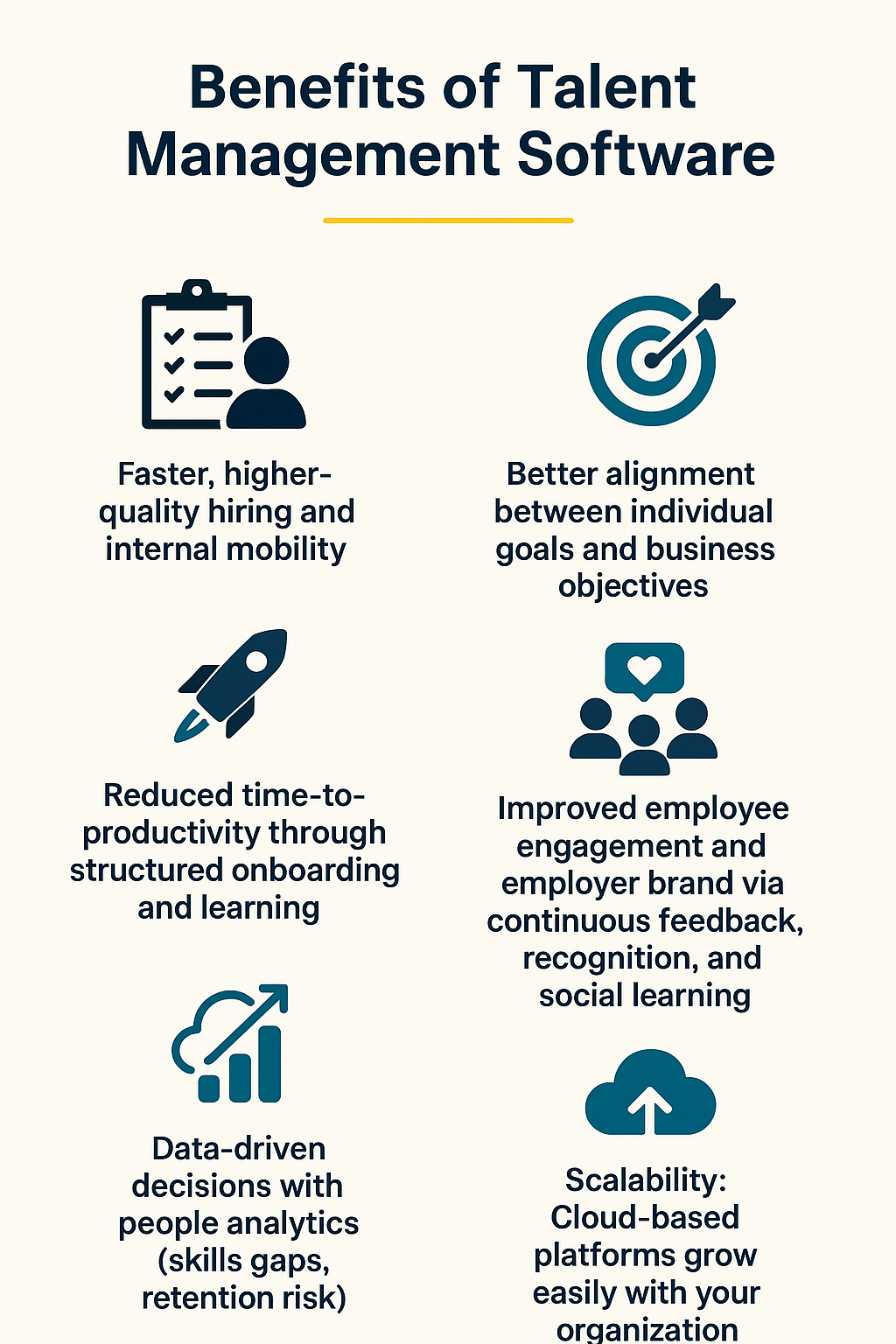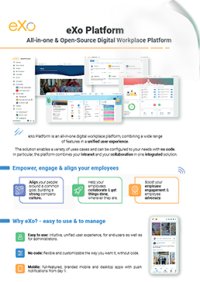


FREE WHITE PAPER
Discover our in-depth analysis of the concept of employee engagement, its roots, and ways to improve it significantly
Talent management is no longer an HR-side checklist — it’s a strategic, technology-enabled system that ensures organizations have the right people with the right skills in the right roles. More importantly, it keeps employees engaged, motivated, and aligned with business objectives.
Modern talent management platforms don’t just automate HR tasks—they create an employee experience that boosts retention, engagement, and performance. A recent study by McKinsey shows that organizations with strong talent management capabilities are 2.2 times more likely to outperform peers on financial metrics (McKinsey).

This guide explains what talent management means today, how software and platforms differ, the most important modern features (including AI-driven ones), real-world use cases, and why solutions like eXo Platform offer a future-proof approach.
Talent management refers to the strategic, holistic approach an organization uses to attract, onboard, develop, engage, and retain employees in alignment with business goals. Instead of treating HR as merely administrative, modern talent management envisions the workforce as an empowered, purpose-driven engine of performance.
Most organizations define talent management through these interconnected stages:
👉 In summary: Talent management is about ensuring your workforce has the right skills, motivation, and career pathways to deliver on organizational strategy.
Talent management software, platforms, and solutions are digital tools designed to automate and streamline these critical HR functions. While the terms are often used interchangeably, there are subtle differences:
Talent management is no longer an HR-side checklist. It’s become a strategic, organisation-wide priority driven by three converging forces:
Roles are evolving faster than ever. According to the World Economic Forum, 44% of workers’ core skills will change by 2030, creating urgent demand for continuous reskilling and upskilling programs. Without proactive talent management, organisations risk falling behind as skill gaps widen.
Engagement and retention have become mission-critical. Research by Gallup shows that highly engaged teams achieve 21% greater profitability and reduce absenteeism by nearly 41%. When companies invest in internal mobility, career development, and recognition, they reduce costly turnover and time-to-fill critical roles.
Artificial intelligence now enables organisations to match skills to roles, predict attrition risks, and personalise learning at scale. According to a Financial Times report, more companies are using AI to gain workforce insights, but adoption must be balanced with ethical considerations and strong human oversight. As Lifewire highlights, AI’s true value lies in augmenting—not replacing—human decision-making.
A strategic approach to talent management is no longer optional—it’s a business imperative in today’s competitive, fast-changing workplace. Here’s why:
The Society for Human Resource Management (SHRM) estimates the cost of replacing an employee at 50–200% of their annual salary (source). By offering career pathing, targeted development, and recognition, organisations increase loyalty and reduce churn.
Engaged employees are consistently more productive. Companies with strong talent management strategies—clear goals, ongoing feedback, and tailored learning opportunities—see measurable performance gains.
Modern platforms provide real-time analytics on skills gaps, succession readiness, and turnover risks. This allows HR to move from intuition to evidence-based workforce planning, strengthening alignment with business strategy.
Organisations known for investing in people and promoting from within become talent magnets. This not only reduces recruitment costs but also shortens time-to-hire, giving companies a competitive edge in tight labor markets.
Through succession planning and leadership development, organisations prepare for inevitable market disruptions. A talent pipeline ensures continuity and resilience, keeping the business agile in uncertain times.

The Complete Guide to
Employee Engagement
Discover our in-depth analysis of the concept of employee engagement, its roots, and ways to improve it significantly



Discover our in-depth analysis of the concept of employee engagement, its roots, and ways to improve it significantly
Modern talent management platforms are modular, flexible, and increasingly intelligent, designed to support the full employee lifecycle—from hiring to development, engagement, and succession. Most comprehensive platforms are built around several core modules:
These modules streamline the hiring process with features such as candidate sourcing, automated pipeline management, interview scheduling, and collaborative hiring workflows. Advanced ATS platforms now use AI to match skills with roles and predict candidate success (SHRM).
Digital onboarding simplifies paperwork, introduces new hires to teams, and provides cultural orientation. Platforms may include task checklists, interactive guides, and automated reminders to ensure a smooth transition and accelerate time-to-productivity.
Performance modules track goals through OKRs and KPIs, enable continuous feedback, and facilitate 360-degree reviews and regular check-ins. Modern systems often integrate real-time performance analytics, helping managers identify high performers and areas for improvement (Gallup, 2023).
L&D modules offer course libraries, curated learning paths, skill assessments, and certification tracking. AI-driven platforms can recommend personalized learning based on skill gaps, career paths, and performance trends, helping organizations future-proof their workforce.
These modules manage salary planning, bonus allocation, and benefits administration, ensuring fair and competitive compensation practices. Analytics can also help organizations model pay equity and reward high-impact employees effectively.
Succession modules help identify critical roles, assess candidate readiness, and create development plans for high-potential employees. They ensure continuity in leadership and mitigate risks associated with unexpected departures (Forbes, 2024).
Employee engagement tools include pulse surveys, recognition systems (points, badges, awards), and feedback channels. High engagement correlates with 21% higher profitability and lower turnover, making this module a strategic investment (Gallup).
Platforms themselves are designed with varying architectures and scopes, depending on organizational needs:
These focus on excelling in a single area, such as recruitment (Lever, Greenhouse), performance (15Five, Lattice), or learning (Degreed, Coursera for Business). They often integrate with broader HCM systems for end-to-end HR coverage.
All-in-one platforms like SAP SuccessFactors, Workday, and Oracle HCM Cloud combine core HR functions (payroll, compliance, employee data) with talent modules. They are strong on compliance, reporting, and unified workforce analytics (Lifewire, 2023).
Platforms like eXo Platform prioritize user experience, collaboration, and engagement alongside talent management features. They integrate intranet, social collaboration, learning, and recognition tools to create a unified digital workplace where people are motivated, informed, and continuously developing.
These are specialized tools for a single function—such as ATS, LMS, or performance tracking—often implemented independently or connected via integrations. They are ideal for organizations that need specific capabilities without a full-suite investment.

Talent management software (TMS) is more than just an HR tool—it’s a strategic enabler that drives performance, engagement, and business outcomes. Organizations investing in modern TMS can expect a wide range of benefits across hiring, development, retention, and workforce planning.
A modern TMS streamlines recruitment by automating applicant tracking, candidate evaluation, and interview workflows. Beyond external hiring, it enables internal mobility, helping HR identify employees who are ready to step into new roles or take on stretch assignments. According to SHRM, companies with strong internal mobility programs retain talent longer and reduce time-to-fill critical roles (SHRM, 2023).
Performance management modules allow organizations to define clear goals (OKRs, KPIs) and link them to overall business objectives. Continuous feedback and check-ins ensure employees understand how their work contributes to the company’s strategy. Gallup research shows that employees whose goals align with business objectives are significantly more productive and engaged (Gallup, 2023).
Structured onboarding, task management, and personalized learning paths help new hires become productive faster. By providing clear expectations, digital checklists, and interactive learning, organizations can shorten ramp-up time while improving retention. Organizations with structured onboarding programs report up to 60% faster integration of new employees (Forbes, 2023).
Modern TMS platforms provide real-time people analytics, including skill gaps, succession readiness, retention risks, and engagement trends. HR and leadership can move from intuition-based decisions to evidence-based workforce planning, improving outcomes for both employees and the organization. AI-powered insights can even predict attrition and recommend targeted learning interventions (Financial Times, 2024).
Employee engagement modules, recognition tools, and social learning features create a culture of continuous feedback and development. High engagement correlates with 21% higher profitability and lower turnover (Gallup, 2023). A company known for investing in employee growth and experience also strengthens its employer brand, attracting top talent in competitive markets.
A modern platform breaks down data silos, providing a single source of truth for HR metrics, talent insights, and workforce trends. This unification supports more strategic decision-making, better compliance, and easier reporting.
User-friendly, mobile-first interfaces increase adoption and satisfaction. Employees can access learning, feedback, recognition, and career development tools anytime, anywhere, enhancing engagement and productivity.
Routine HR tasks—such as review cycles, reminder emails, or reporting—can be automated, freeing HR teams to focus on strategic initiatives. Automation also reduces errors and ensures consistency across processes.
Cloud-based TMS platforms help organizations stay updated with changing labor laws and regulatory requirements. Documented workflows and audit trails reduce risk and simplify compliance reporting.
Cloud-based platforms can scale easily as the organization grows, whether adding new employees, opening new locations, or expanding into international markets. With AI-driven insights and modular capabilities, modern TMS helps organizations stay resilient and agile in a constantly changing business landscape.
The talent management software market is growing rapidly, driven by digital transformation, AI adoption, and a focus on employee experience. Analysts at The Business Research Company highlight that AI-enabled capabilities and integrated analytics are major factors in driving adoption across industries.
In short, investing in a modern talent management platform is no longer optional—it’s a strategic move that enhances hiring, productivity, engagement, and long-term organizational resilience.
Choosing the right talent management platform is no longer just an HR checklist task — it’s a strategic decision that impacts hiring quality, employee development, engagement, and retention. Modern platforms are not mere automation tools; they are intelligent systems designed to enhance every stage of the employee lifecycle. Below is a comprehensive guide to the features that truly matter in 2024–2025, with insights from recent studies and market reports.
A strategic talent management platform should cover the entire employee journey: attraction, hiring, onboarding, development, performance management, succession planning, and retention. Look for integrated modules that seamlessly flow from one stage to another to avoid data silos and repetitive processes.
Today’s platforms are distinguished by AI, analytics, and predictive modeling, enabling organizations to make smarter decisions.
A platform isn’t successful unless employees actually use and engage with it. Modern solutions embed talent management into the workflow rather than isolating it in HR systems.
Every organization is different, and your platform should adapt, not the other way around.
Use this checklist during vendor demos to ensure you select a solution that fits both your current and future needs:
| Feature Area | Questions to Ask | Why It Matters |
| Lifecycle Coverage | Does it support recruit → onboard → develop → retain? | Ensures smooth transitions and avoids fragmented systems |
| Skills Management | Canonical skills taxonomy + automated tagging? | Enables personalized learning, internal mobility, and succession planning |
| Learning & Development | LMS + microlearning + external content integrations? | Facilitates continuous upskilling & employee growth |
| Performance | Continuous feedback, OKRs, manager workflows? | Moves from annual reviews to real-time performance culture |
| Internal Mobility & Succession | Talent pools, internal marketplace, candidate profiles? | Retains top talent by creating career opportunities within the organization |
| Analytics | Dashboards, predictive models, exportable reports? | Supports strategic, data-driven HR decisions |
| Integration | HRIS, payroll, collaboration tools, SSO? | Avoids data silos and ensures seamless workflows |
| Security & Compliance | Cloud/on-premise/hybrid, audit trails, privacy controls? | Essential for regulated industries and data protection |
| UX & Adoption | Mobile app, social learning, gamification, communities? | Drives usage and engagement, ensuring ROI on the platform |
| Vendor Stability | Partners, services, customer base? | Reduces risk and ensures long-term support |
Selecting the right talent management platform requires balancing end-to-end lifecycle coverage, data-driven insights, employee experience, and flexibility. The best platforms in 2025 go beyond HR automation—they are intelligent, integrated, and people-focused solutions that enhance engagement, productivity, and workforce agility. With AI, predictive analytics, and modern learning tools, your organization can truly turn talent management into a strategic advantage.

In today’s workplace, talent management is no longer just about processes and compliance—it’s about experience, engagement, and embedding development into everyday work. While traditional HR and HCM suites focus primarily on recruiting, payroll, and performance management, eXo Platform distinguishes itself by placing the employee experience at the center of talent development. This approach transforms standard HR tools into a living, collaborative ecosystem where employees are motivated, connected, and empowered.
eXo Platform is more than a talent management system. It is an open-source digital workplace that unifies collaboration, communication, knowledge management, and talent development in a single hub. By integrating social networking, chat, project management, wikis, and document management, eXo ensures that talent management is not a standalone function but part of daily workflows.
eXo Platform continues to evolve, incorporating modern functionality that aligns with the latest trends in talent management and employee experience.
Studies and reports confirm that platforms prioritizing engagement, AI-driven skills matching, and integrated learning are among the highest investment areas in 2025 (Mercer, 2025; The Business Research Company, 2025).
| Feature | eXo Platform | Traditional TMS (e.g., SAP SuccessFactors, Workday) |
| Primary Focus | Employee experience, collaboration, and culture | HR process automation (recruitment, performance, compliance) |
| Core Functionality | Social networking, chat, communities, document management, project tools | ATS, LMS, performance reviews |
| Customization | High (open-source, APIs) | Limited; often rigid |
| Integration | Strong with collaboration tools (Microsoft 365, Google Suite, Zoom, Slack) | Strong with HR/payroll systems but less flexible for daily work tools |
| Employee Engagement | Built-in via gamification, recognition feeds, and communities | Often requires separate add-ons |
| Deployment | Cloud, on-premise, or hybrid | Mostly cloud/SaaS; some hybrid options |
| Target Users | All employees and managers, modern hybrid workforce | Primarily HR, managers, and employees for task-specific workflows |
| Criteria | eXo Platform | Workday | SAP SuccessFactors | Cornerstone OnDemand | BambooHR |
| Positioning | Open-source digital workplace + EXP with talent development features | Enterprise HCM, strong AI features | Global HCM & payroll | Learning & performance specialist | SMB-focused HRIS/ATS |
| Best For | Organizations prioritizing engagement, internal mobility, and integrated workflows | Large enterprises needing analytics + HR integration | Globally distributed firms with complex HR needs | Learning/performance-focused organizations | Small/mid businesses seeking simple HRIS |
| AI & Analytics | People analytics, community insights, engagement tracking | Advanced AI in recruiting and mobility | Reporting + talent modules, expanding AI | Learning analytics | Limited |
| Deployment | Cloud, self-host/on-premise | Cloud SaaS | Cloud/hybrid | Cloud | Cloud |
| Integration | API-first, collaboration-focused | Broad enterprise integrations | Broad enterprise integrations | LMS/HR focused | Moderate |
| TCO | Lower for self-hosted/customized deployments | Higher SaaS costs | Enterprise licensing | Subscription-based | Lower |
The evolution from talent management software to a talent management experience signifies a fundamental shift in how organizations value their people. The goal is no longer just to manage efficiently but to inspire, connect, and empower.
While traditional HCM suites are powerful engines for process and data, platforms like eXo Platform provide the heart and soul of the modern digital workplace. By prioritizing user experience, seamless integration, and genuine engagement, eXo Platform doesn’t just help you manage your talent—it helps you build a community that attracts and retains top talent for the long term.
When choosing your talent management platform, ask yourself: Do we want to implement a rigid system of control, or do we want to cultivate a vibrant ecosystem of growth? Your answer will guide you to the right solution.
Ready to see it in action? Explore eXo Platform’s capabilities and request a demo on our official website.

eXo Platform : The Open-Source
Digital Workplace Platform
Download the eXo Platform Datasheet and discover all the features and benefits


Download the eXo Platform Datasheet and discover all the features and benefits
You will find here Frequently Asked Questions about Talent Management with all the answers in one place.
Talent management refers to the strategic, holistic approach an organization uses to attract, onboard, develop, engage, and retain employees in alignment with business goals. Instead of treating HR as merely administrative, modern talent management envisions the workforce as an empowered, purpose-driven engine of performance.
Talent management is no longer an HR-side checklist. It’s become a strategic, organisation-wide priority driven by three converging forces:
A strategic approach to talent management is no longer optional—it’s a business imperative in today’s competitive, fast-changing workplace. Here’s why:
💪 Improved Retention & Reduced Turnover
🚀 Increased Productivity & Performance
📊 Data-Driven Decision Making
🌟 Stronger Employer Brand
🔮 Future-Proofing the Organisation
In a knowledge-driven economy, where talent is often the most important differentiator, effective talent management has become a cornerstone of business strategy.
In short, talent management isn’t just about filling roles—it’s about creating a resilient, engaged, and future-ready workforce.
Modern talent management platforms are modular, flexible, and increasingly intelligent, designed to support the full employee lifecycle—from hiring to development, engagement, and succession. Most comprehensive platforms are built around several core modules:
🧩 Core Talent Management Modules
💻 Common Types of Talent Management Platforms
Platforms themselves are designed with varying architectures and scopes, depending on organizational needs:
Talent management software (TMS) is more than just an HR tool—it’s a strategic enabler that drives performance, engagement, and business outcomes. Organizations investing in modern TMS can expect a wide range of benefits across hiring, development, retention, and workforce planning.
( Your e-mail address will not be published)
I am a Digital Marketing specialist specialized in SEO at eXo Platform. Passionate about new technologies and Digital Marketing. With 10 years' experience, I support companies in their digital communication strategies and implement the tools necessary for their success. My approach combines the use of different traffic acquisition levers and an optimization of the user experience to convert visitors into customers. After various digital experiences in communication agencies as well as in B2B company, I have a wide range of skills and I am able to manage the digital marketing strategy of small and medium-sized companies.